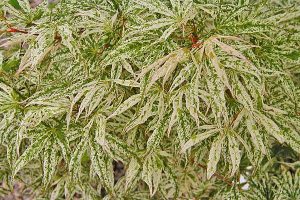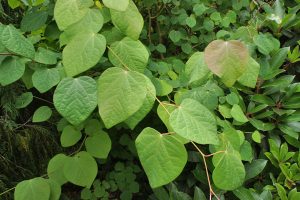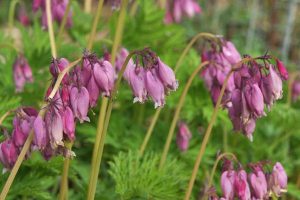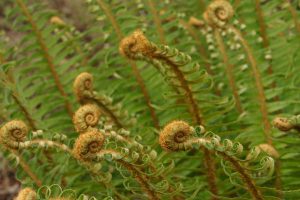
Download a pdf of Plants for Problem Places: Shade
Many gardens in the Northwest have the fortune of old conifers as part of their makeup. These spectacular trees are a wonderful sight, but gardening under them can be a challenge. The deep shade of mature evergreens prevent many flowering plants from setting buds, but there are plants that work well in deep shade, bring light and color to the forest garden. We have put together a list of some plants that do quite well in partial to full shade.
Trees and Shrubs
- Acer circinatum Vine Maple. Our native understory maple, which, in deep shade, takes on an open, graceful form, often with green bark, and has butter yellow fall color. Some dwarf cultivars exist.
- Acer palmatum Japanese Maple. Small to medium sized deciduous trees. Avoid red leafed forms, as most will not be red in dense shade. Variegated forms, such as ‘Ukigumo’ and cultivars that have golden or chartreuse foliage like the Full Moon Maple are brilliant shade trees.
- Arbutus unedo Strawberry Tree. Small evergreen trees with glossy green leaves, growing 6′-15′, depending on variety. Somewhat tolerant of drought when established.
- Aucuba japonica Evergreen shrubs, growing to 4′-12′, depending on cultivar, many with variegated leaves available. Plant either self-fertile varieties, like ‘Rozannie’, or plant both male and female cultivars for the bright red berries. Tolerant of dry shade once established.
- Camellia sp. Evergreen shrubs growing to 8′ or more. Need some bright light or sun during their new growth period (May and June) to develop flower buds.
- Cornus sp. Redtwig and other shrub Dogwoods. Brilliant young wood gives winter interest, some varieties have variegated foliage to brighten shade, tolerates wet soil.
-

Disanthus cercidifolium, Redbud Hazel, summer foliage
Disanthus cercidifolium Redbud Hazel. Deciduous shrub growing to 10′ in time, heart shaped leaves turn wine red in autumn, even in deep shade. Needs summer moisture.
- Gaultheria sp. Salal and relatives. Low, evergreen shrubs, often spreading habit, can tolerate some drought when established.
- Hydrangea sp. Deciduous shrubs from 2′-8′ depending on variety. Needs some light to flower well. Not drought tolerant.
- Lonicera pileata Privet Honeysuckle. Low growing, evergreen shrub tolerant of light shade, drought tolerant once established.
- Mahonia sp. Oregon Grape. Evergreen shrubs. Our native Mahonia aquifolium and Mahonia nervosa can take dry shade once established. The larger Mahonia hybrids need some summer moisture to thrive.
- Osmanthus sp. Osmanthus, Japanese False Holly, Fragrant Osmanthus. Evergreen shrubs, some varieties with variegated leaves, some with fragrant flowers. Drought tolerant when established.
- Ribes sanguineum Red flowering currant. Native deciduous shrubs, growing 6′-10′. Flowering may decline in deep shade. Prefers well-drained soils.
- Rhododendron sp. Many of the species and hybrid rhododendrons with felting on their leaves perform well in shade. They may not flower well if the shade is too deep. Not drought tolerant.
- Sarcococca humilis Himalayan Sweet Box. Low, spreading evergreen shrub, with glossy leaves and winter fragrant flowers. Drought tolerant when established.
- Taxus baccata English Yew. Several cultivars of yew, including golden forms, that add evergreen texture to deep shade.
- Tsuga sp. Many forms of Western and Canadian hemlock can add evergreen texture to shade. Canadian hemlocks need more light than Western hemlocks. Both need moist summer soil.
- Vaccinium sp. Evergreen and Red Huckleberry. Native evergreen and deciduous shrubs, can reach 8′ in time.
Perennials
- Anemone nemerosa Wood Anemone. Deciduous perennial, low, spreading, with blue or white blooms mid-spring. Tolerates dry shade.
- Aruncus dioicus Goatsbeard A native perennial for shade to partial shade. Tolerant of moist to dry soils.
- Asarum sp. Wild Ginger. Spreading, evergreen to semi-evergreen groundcovers grown for their attractive foliage. Tolerant of dry shade when established.
- Brunnera macrophylla Deciduous to partially evergreen perennials grown for their variegated foliage. Tolerates dry shade once established.
- Bergenia cordifolia Evergreen, bold textured foliage topped in spring by stalks of pink or white flowers. Tolerant of dry shade.
- Darmera peltata A bold perennial native to the Siskyou Mountains of Oregon. Tolerant of winter wet and shade to sun.
- Cornus canadensis Native deciduous spreading groundcover. Small dogwood flowers are followed by bright red berries. Prefers rich, duffy soil.
- Cyclamen coum or hederifolium Hardy cyclamen. Spring or fall blooming over ornamental leaves, both tolerate dry shade.
- Dicentra formosa Pacific Bleeding Heart. Our native deciduous perennial, ferny foliage topped by cheerful pink flowers. Spreads. Tolerates dry shade.
- Epimedium sp. Barrenwort or Bishops Hat. Evergreen or deciduous perennials, slowly spread by stolons. Grown for their attractive foliage and delicate flowers of many colors. Tolerant of dry shade once established.
- Helleborus sp. Mostly evergreen perennials that bloom in a range of colors. Attractive foliage is a plus. Best in well drained, rich soil, but fairly drought tolerant when established.
- Hosta sp. Deciduous perennials grown mainly for their bold, colorful foliage. Best in rich soil with some summer water.
- Oxalis oregona Redwood Sorrel. Native herbaceous groundcovering perennial with shamrock like leaves and white or pink flowers in late spring.
- Mianthemum dilitatum False Lily of the Valley Native lily family plant, spreads to form large colonies. Thrives in moist to wet soil, will tolerate drought when established.
- Smilacena sp. False Solomon’s Seal. Native lily relatives with white flowers, include Smilacena (Mianthemum) racemosa and Smilacena stellata. Best flowering with some light. Tolerant of most soils.

Sword fern fiddles
Ferns
- Blechum sp. Deer Fern, Water Fern. Evergreen ferns, including our native Deer Fern.
- Dryopteris sp. Male Fern, Autumn Fern. Numerous varieties of deciduous and evergreen ferns.
- Gymnocarpus dryopteris Oak Fern Native deciduous fern, preferring moist soil. Can spread to form carpets.
- Polystichum sp. Sword Fern, Shield Fern, Tassel Fern. Numerous varieties, mostly evergreen ferns, including our native Sword Fern, which tolerates dry shade.
Grasses
- Carex sp. Several sedge varieties do well in shade that have variegated or golden foliage.
- Hakonechloa macra Japanese Forest Grass. Deciduous grasses with soft texture, prefers a moist site.
- Luzula sp. Evergreen or deciduous grasses, available in variegated and golden forms, tolerant of dry shade.
